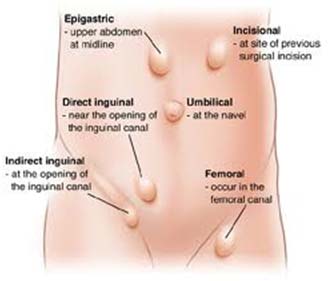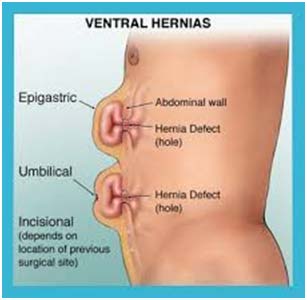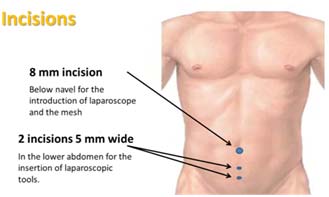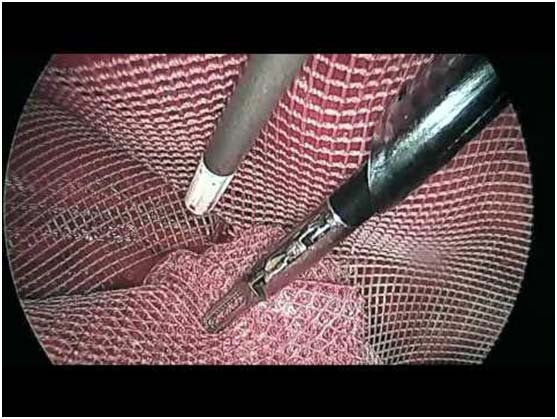Hernia surgery, also known as herniorrhaphy or hernioplasty, is a surgery that involves the repair of an abdominal wall defect with or without a prosthesis or mesh. Hernia occurs when a small part of your intestine or other internal organ protrudes through a weaker spot in your abdominal wall. Hernia can give rise to symptoms like localized swelling, pain, and heaviness and in severe cases can lead to complications like intestinal obstruction and gangrene.
This surgery is recommended to avoid serious complications such as strangulation or obstruction of bowel movement and general movement.
There are primarily two main approaches to hernia surgery:
1. Open surgery: The surgeon cuts the groin, sutures the hernia, and closes it. It can use a scaffold or mesh in the weakened area to prevent further injury and boost tissue growth in the affected area.
2. Laparoscopic surgery: Minute incisions are made with the insertion of a camera to lead the surgeon with enhanced magnification and clarity.
3. Robotic surgery: It is similar to laparoscopic surgery, but the procedure is carried out through robotic arms controlled by the surgeon. It is the upcoming standard of care for hernia surgery.
A leading hernia surgeon in Delhi will first evaluate your condition thoroughly and then determine the most suitable type of surgery for you.
There are a whole lot of hospitals and clinical infrastructures in Delhi that specialize in hernia surgery. There are various ways of finding out the best hospital and care center for you, through research or healthcare consulting or, maybe talking to an experienced gastrointestinal surgeon.
A hernia is a defect in the muscular wall through which an organ protrudes outside the cavity in which it normally resides.
Depending on the cause and location of the defect, symptoms may vary. The patient seeks medical consultation when it causes pain, discomfort, or more severe symptoms like intestinal obstruction/gangrene.

There are several types of hernias, and a few of the most common ones are listed below:
• Inguinal Hernia: This is the most common type of hernia, and the one mostly found in men. It is a medical condition where tissue bulges through the inguinal canal, which is just a passage in the lower part of the abdominal wall. These are generally categorized under direct and indirect inguinal hernia.
• Femoral Hernia: Femoral hernias occur less often than inguinal hernias. It is more common among women because of the wider pelvis.
• Umbilical Hernia: Abdominal organs bulge out of the abdominal cavity through a weakness in the umbilical scar. It may present slightly above or below the umbilicus or may present as an umbilical swelling. Most often this type of hernia occurs in babies, although adults can be affected as well.
• Ventral Hernia: It may be such that it happens near the belly button or through an incision made during surgery (incisional hernia).

These types are the most common, though other less frequently occurring hernias may also occur. A bulge or pain in the abdomen should always be consulted with a doctor for proper assessment and treatment.
Understanding the causes and risk factors can help you take steps to prevent hernias and manage your condition if you're diagnosed.
Common Causes:
» Pressure on the Abdomen: Activities like lifting heavy objects improperly, chronic coughing, constipation, or pregnancy can put a strain on your abdominal muscles.
» Weakened Abdominal Muscles: Over time, your abdominal muscles can become weaker, especially after surgery or due to underlying health conditions.
Risk Factors:
You are more susceptible to developing a hernia if you have:
* Previous abdominal or pelvic surgeries
* Severe obesity
* Chronic allergies leading to persistent cough
* Constipation
* Pregnancy
* A job that involves heavy lifting or prolonged time standing e.g rickshaw-pullers, weightlifters
Your child may be vulnerable to congenital hernia if they:
• Are born prematurely
• Have a connective tissue disorder
• Have cystic fibrosis
• Have undescended testicles
• Have congenital hip dysplasia
Many times, hernias can easily be diagnosed by an obvious bulge or protrusion in your abdomen, groin, or other lower body areas. While this is the most common symptom, not everyone who has a hernia experiences it.
Other Common Symptoms:
•; Pain/Discomfort: Aching pain, burning, or stabbing pain in the affected area, especially with lifting and bending.
• Groin-related symptoms: Weakness, pressure, or swelling in the groin.
Vomiting, pain, or swelling around the testicles (in males)
The specific symptoms you experience will depend on the type of hernia you have. For example, hiatal hernias often cause reflux, heartburn, and upper abdominal pain.
The type of hernia surgery will depend on various factors like the size and location of the herniated area, the type of hernia, and your general state of health.

Common Hernia Repair Techniques:
» Open Surgery: Under this conventional procedure, a more significant cut can be provided on the affected area. The surgeon can also reduce the hernia and provide support to the same mesh if considered necessary. This open type of surgery usually demands a longer time for its recovery process.
» Laparoscopic Hernia Surgery: Quite minimally invasive because it just happens using small incisions, and a camera for added precision. The hernia is usually repaired with a scaffold or mesh. Generally, laparoscopic surgery offers quicker recovery, when compared to open surgery.
» Robotic Surgery: Like a laparoscopy, this is carried out using computer-controlled robotic arms. This surgery also comes with the advantages of laparoscopic surgery; it involves a small wound and rapid recovery.
Your doctor will be able to discuss the best option for you.

Laparoscopic hernia surgery is another minimally invasive procedure instead of open surgery, which is widely adopted today.
The patient receives a few little incisions next to the belly button. A scope attached to the camera captures images of your internal organs onto a screen in real time.
Steps of Laparoscopic Hernia Surgery:
1. Preparation: A pre-operative evaluation will be done like blood tests, and other kinds of preoperative studies if necessary.
2. Surgery: A dosage of anesthesia will be given to you so that you do not feel anything during your surgery.
3. Incisions: Several small cuts are made near your navel, for operating the hernia.
4. The scope attached with a camera is inserted through the incision
5. Gas Inflation: Carbon dioxide (CO2) gas is slowly inflated in your abdomen for better visualization.
6. Hernia Repair: The hernia is reduced, and the defect is reinforced with a prosthesis like a mesh.
7. Closure: The incisions are sutured or closed with surgical-grade glue.
• Minimal Scarring: As a result of the procedure, you'll have three-minute scars rather than one large incision. You can even be discharged the next day after the surgery, depending upon your general recovery.
• Less Pain: Laparoscopic surgery often results in less post-operative pain.
• Faster Recovery: You are often able to return to work and your usual activities more quickly than with open surgery.
• Lower Costs: Laparoscopic surgery may result in lower costs overall because of the lesser number of hospital days or lost time from work.
Robotic hernia surgery is the technologically enhanced solution for hernia repair. This involves minimally invasive surgical processes, which have made hernia repairs more precise. There are many advantages of this technology over the open procedure.
1. Robotic arms are particularly flexible and nimble, providing even more subtle and precise movements, including some that pertain to and happen to be relevant to complex hernias.
2. Improved visualization on 3D, high-definition imaging enhances depth perception and visualization of the surgical site.
3. Higher precision ensures little to minimal damage around the tissues, thus faster recovery with comparatively lesser pain.
4. Robotic surgery requires smaller incisions and leaves very tiny scars.
5. The method is very detailed so that the post-operative risk of hernia recurrence among patients could be minimal, especially in complicated cases.
• Patients with multiple previous hernia repairs or complications
• Recurring hernia complications
• Those who want to have their post-operative period shorter and less painful.
» Overweight or obese people.
• Pre-Operative: The patient will have detailed imaging and other diagnostic tests, and a determination about the best type of surgery to be performed on them.
• Intraoperative: The surgeon inserts robotic arms into the abdomen through small incisions to repair the hernia. Most surgeons use mesh or scaffold as an added layer of reinforcement for the repair.
• Postoperative: Recovery time is similar to laparoscopic surgery but is even more rapidly achieved by some patients.
• Minimal scars post-surgery for a better cosmetic result
• Shorter recovery time to resume normal activities and work (typically within 1-2 weeks)
• Lesser pain and discomfort after the surgery
• Shorter hospital stays
Robotic hernia surgery offers the patient an advanced technique for the repair of a hernia via a minimally invasive yet highly effective method. Discuss the advantages of robotic surgery with your doctor if hernia surgery is considered.
Complications with a hernia may develop if the herniated tissue becomes incarcerated (stuck in the place) or obstructed. If the tissue that is incarcerated does not receive adequate blood flow, it could lead to necrosis of the tissue.
• Bowel Obstruction: If the hernia causes blockage of normal movement of contents in the intestines, an obstruction will occur, and food and gas will not pass through it.
•Tissue Death: Strangulation of the herniated tissue may lead to a loss of blood supply to the tissues; as a result, tissue death may occur, and emergency surgery will be required.
• Congenital Diaphragmatic Hernia (CDH): These are usually born with severe complications since diaphragmatic hernia affects the normal development of the fetal organs. Infants are usually put in an intensive care unit. • Chronic Acid Reflux: Possibly complicated by hiatal hernias through chronic acid reflux. Other complications are rare.
Follow all pre-operative and post-operative orders from your healthcare advisors as closely as possible, because that's where the healing takes place and outcomes are the best as they can be.
• Recovery Room: This is where you will be taken following your surgery and closely monitored until the anesthesia effects start to wear off.
• Pain Management: Your caregivers will try to manage pain with techniques and medications that make you comfortable in the initial stages of recovery.
• Post Operative Instruction: You will get particular instructions about postoperative care along with some restriction of activity. Besides that, you will be informed about follow-up visits that may be necessary or required.
• Duration of Hospital Stay: You may be able to go home the same day depending on the type of procedure selected and also on an individualized basis.
• Return to Normal Gradually: Resumption of normal activities generally will occur gradually consistent with the plan you devise with your surgeon.
• Dietary Advice: It may be advised for the patient to follow a special diet that will be crafted by your surgeon and dietician.
• Follow-up care: Your surgeon will follow your progress with reviewal appointments, which will allow him or her to see how well you are healing and attend to any problems that may have arisen.
Pain from hernia is one thing that may be seriously troublesome. In case you have a bulge in the stomach or groin and are experiencing pain or discomfort, or a digestive problem, seek medical help from an expert, as soon as possible.
We have an excellent team of skilled and experienced surgeons in Delhi dedicated to giving you the very best medical care possible.
Why us?
• Our surgeons have years of experience in the diagnosis and treatment of various types of hernias, such as inguinal, femoral, umbilical, and incisional hernias.
• We take pride in using state-of-the-art surgical techniques and technologies with minimal invasiveness, speedy recovery time, and optimal patient outcomes.
• Every patient gets personal attention along with a treatment plan that is devised according to their needs.
• We are here for you, every step of the way throughout your treatment journey. We're here to give you compassionate and caring support.
Don't wait. Call us today to book a consultation with one of our leading hernia surgeons in Delhi. We'll guide you in making better decisions about your health.
Delhi, India, has developed into a world health capital, known by the presence of high-class infrastructure along with highly qualified medical professionals. Hernia repair surgery is no exception to this. This West Minster City remains at par with other prime destinations in the world when it comes to the best practice and is considered one of the most reliable cities for hernia repair surgeons.
Don't let the pain or discomfort of a hernia condition restrict your life.
Make an appointment today with one of the best hernia surgeons in Delhi and get the appropriate treatment for you, with the maximum chances of quick recovery. Schedule a consultation to discuss your condition of a hernia and determine the right surgical procedure for you.